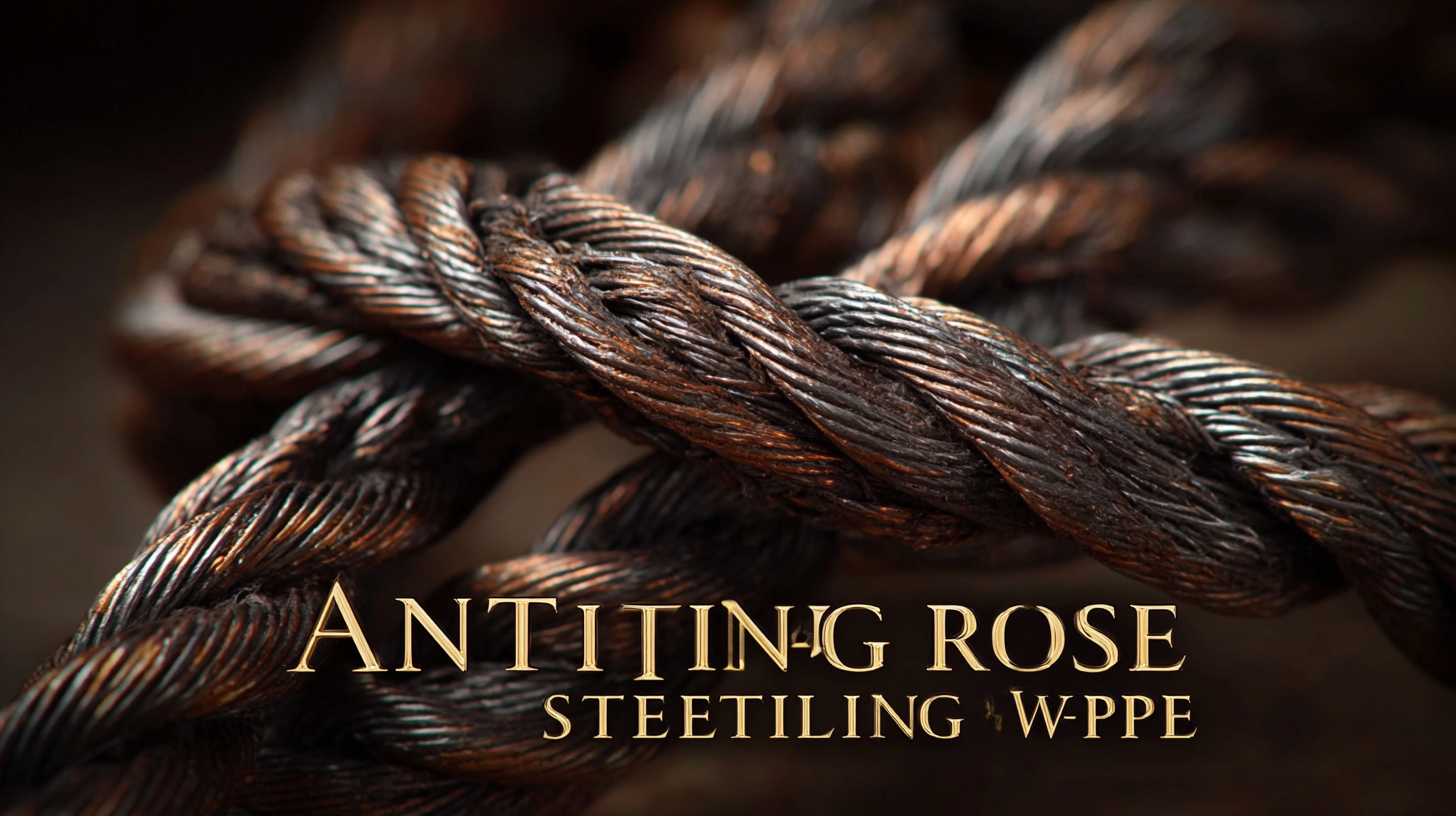Mastering the Art of Selection: A Comprehensive Guide to Choosing the Best Anti Twisting Steel Rope
In the world of industrial applications, the demand for high-performance materials is ever-increasing, particularly in the realm of lifting and rigging solutions. Among these,
Anti Twisting Steel Rope has emerged as a critical component, essential for various sectors including construction, maritime, and manufacturing.
According to a recent industry report by
Research and Markets, the global steel rope market is projected to reach
$7.5 billion by 2025, with anti-twisting variants gaining significant traction due to their superior safety features and durability.
As companies around the globe strive for innovation and efficiency,
mastering the art of selection for Anti Twisting Steel Rope becomes paramount.
This guide aims to provide a comprehensive understanding of the key factors to consider when choosing the best option for your specific needs, underscoring the precision craftsmanship synonymous with
Chinese manufacturing that serves a global market.

Understanding Anti-Twisting Steel Rope: Key Features and Benefits
Anti-twisting steel ropes are essential in various industrial applications, particularly in lifting and rigging operations. They are designed to prevent the rope from twisting under load, a critical feature that enhances safety and efficiency. According to the Industrial Rope Association (IRA), the demand for anti-twisting ropes has surged by over 15% in recent years due to increased safety regulations and a growing focus on equipment reliability. These ropes typically incorporate a unique construction that combines multiple strands, which not only helps mitigate twisting but also increases flexibility and reduces strain during operation.
One of the key benefits of anti-twisting steel ropes is their ability to minimize wear and tear caused by rotational forces. A study conducted by the American Society of Mechanical Engineers (ASME) reported that using anti-twisting ropes can extend service life by up to 30%, significantly reducing maintenance costs for companies. Furthermore, these ropes offer superior load-carrying capabilities, often surpassing that of conventional ropes. For industries such as construction and marine, selecting the right anti-twisting steel rope can lead to enhanced safety measures, ensuring that heavy loads are moved confidently without the risks associated with rope failure.
2025 Trends in Steel Rope Technology and Innovations
As we look towards 2025, the landscape of steel rope technology is set to witness significant advancements that promise enhanced performance and durability. One of the most exciting trends is the integration of smart materials that can monitor stress and wear in real-time. This technology not only increases safety by providing instant feedback on the rope's condition but also allows for predictive maintenance, ultimately reducing downtime and prolonging the lifespan of the equipment.
Another key innovation expected in 2025 is the development of lightweight, high-strength alloys that will redefine applications across industries. These advanced materials will provide the necessary strength to withstand extreme conditions while minimizing the weight burden on lifting and rigging systems. Moreover, improved coating technologies will enhance resistance to environmental factors such as corrosion and abrasion, making steel ropes even more reliable in harsh conditions. As industries continue to adopt these innovations, the importance of mastering the selection process will become increasingly crucial for achieving efficiency and safety in operations.

Comparative Analysis of Anti Twisting Steel Rope Alternatives
When it comes to selecting anti-twisting steel ropes, understanding the available alternatives is crucial for ensuring optimal performance and safety in various applications. The global steel wire rope market was valued at approximately $2.5 billion in 2022 and is projected to grow at a CAGR of 4.5% until 2030, indicating a rising demand for effective lifting solutions. Key alternatives such as fiber ropes and synthetic ropes have garnered attention, particularly in terms of weight reduction and flexibility. According to a report by MarketsandMarkets, the synthetic rope market is expected to reach $1.2 billion by 2025, reflecting a growing preference for these materials in industries such as marine and construction.
While traditional anti-twisting steel ropes offer high tensile strength and durability, alternatives like High Modulus Polyethylene (HMPE) ropes provide significant advantages in specific scenarios. HMPE ropes are approximately one-seventh the weight of steel, while maintaining an impressive strength-to-weight ratio, making them suitable for applications where reducing load weight is critical. However, it’s essential to consider environmental factors, as steel ropes are inherently more resistant to abrasion and extreme temperatures. This comparative analysis emphasizes the importance of evaluating the specific requirements of each project and the characteristics of the available rope types to make a well-informed decision.
Comparison of Anti-Twisting Steel Rope Alternatives
Factors to Consider When Selecting the Right Rope for Your Needs
When selecting the right anti-twisting steel rope for your needs, several key factors should guide your decision-making process. First, consider the rope's tensile strength, which is critical for ensuring it can withstand the specific loads you plan to subject it to. Assessing the working load limit (WLL) is essential; it helps you choose a rope that not only meets but exceeds your required strength to accommodate any unexpected stresses. Additionally, the diameter of the rope plays a vital role in balancing flexibility and strength, as a thicker rope typically offers increased durability and resistance to wear.
Next, you should take into account the environmental conditions in which the rope will be used. Exposure to harsh elements such as moisture, chemicals, and temperature fluctuations can affect a rope’s longevity and performance. Therefore, selecting a rope with appropriate coatings or treatments can enhance its resistance to corrosion and abrasion. Lastly, it's crucial to analyze the specific application of the rope, such as whether it will be used in lifting, towing, or securing, as these factors can influence design choices, including the type of weave and diameter that will be most effective for your needs.
Mastering the Art of Selection: A Comprehensive Guide to Choosing the Best Anti Twisting Steel Rope
| Rope Diameter (mm) |
Breaking Strength (kN) |
Weight (kg/m) |
Twisting Resistance |
Applications |
| 8 |
25 |
0.38 |
High |
Construction, Lifting |
| 10 |
35 |
0.49 |
Medium |
Marine, Industrial |
| 12 |
45 |
0.68 |
Low |
Heavy Lifting, Hoisting |
| 14 |
55 |
0.88 |
Very High |
Mining, Rigging |
| 16 |
70 |
1.12 |
Medium |
Tower Cranes, Freight |
Future-Proofing Your Projects: Choosing Sustainable Steel Rope Options
 When choosing the best anti-twisting steel rope for your projects, sustainability should be a top priority. As the construction and industrial sectors increasingly emphasize environmentally friendly practices, selecting steel ropes manufactured with sustainable processes allows you to align your projects with these values. Look for products that utilize recycled steel, reducing the demand for virgin materials and minimizing the ecological footprint. Manufacturers that prioritize sustainable practices often provide traceability for their materials, ensuring that you are making responsible choices.
When choosing the best anti-twisting steel rope for your projects, sustainability should be a top priority. As the construction and industrial sectors increasingly emphasize environmentally friendly practices, selecting steel ropes manufactured with sustainable processes allows you to align your projects with these values. Look for products that utilize recycled steel, reducing the demand for virgin materials and minimizing the ecological footprint. Manufacturers that prioritize sustainable practices often provide traceability for their materials, ensuring that you are making responsible choices.
Additionally, consider the longevity and durability of the steel rope you select. High-quality, robust ropes not only enhance performance but also lead to fewer replacements over time, which is beneficial for the environment. Opt for ropes that come with certifications verifying their sustainable production methods. By investing in these products, you contribute to a circular economy, ultimately benefiting future projects and the planet alike. Making informed decisions today sets a precedent for future generations, ensuring that your projects are not only efficient but also environmentally responsible.










 When choosing the best anti-twisting steel rope for your projects, sustainability should be a top priority. As the construction and industrial sectors increasingly emphasize environmentally friendly practices, selecting steel ropes manufactured with sustainable processes allows you to align your projects with these values. Look for products that utilize recycled steel, reducing the demand for virgin materials and minimizing the ecological footprint. Manufacturers that prioritize sustainable practices often provide traceability for their materials, ensuring that you are making responsible choices.
When choosing the best anti-twisting steel rope for your projects, sustainability should be a top priority. As the construction and industrial sectors increasingly emphasize environmentally friendly practices, selecting steel ropes manufactured with sustainable processes allows you to align your projects with these values. Look for products that utilize recycled steel, reducing the demand for virgin materials and minimizing the ecological footprint. Manufacturers that prioritize sustainable practices often provide traceability for their materials, ensuring that you are making responsible choices.